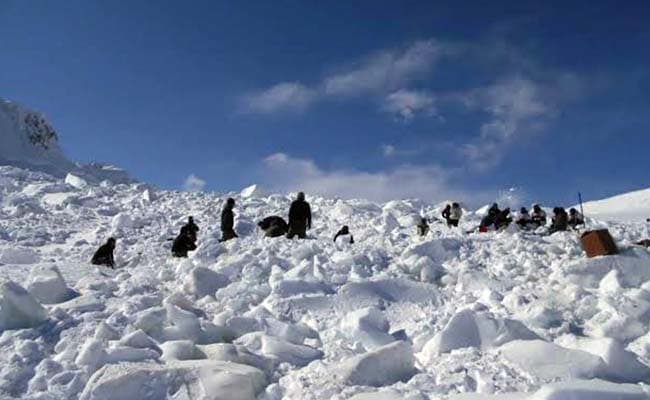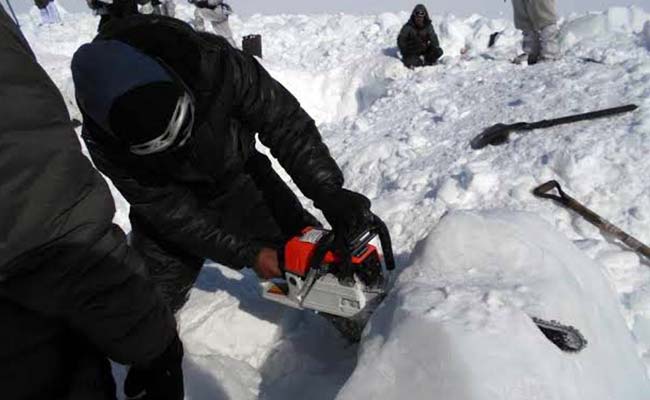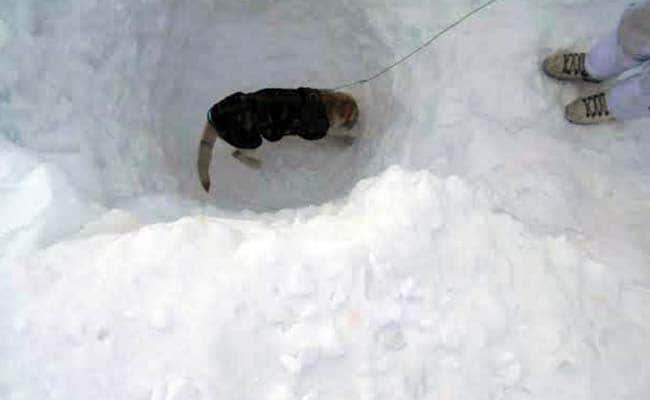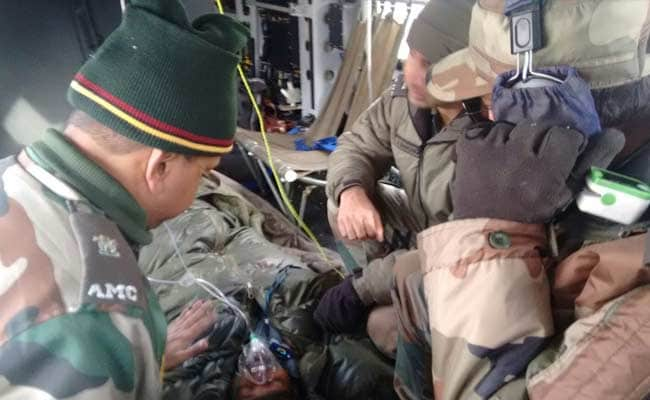It looks like you're using an Ad Blocker.
Please white-list or disable AboveTopSecret.com in your ad-blocking tool.
Thank you.
Some features of ATS will be disabled while you continue to use an ad-blocker.
15
share:
This is extraordinary - near miraculous! An Indian army trooper along with 9 others got caught in an ice avalanche at 20,000 ft where their post was
situated, on the highest battlefield in the world - the Siachen Glacier, North West India.
The video....
Indomitable spirit, courage and the will to survive and live to fight another day sums it all up!
For the full report, log on to http:www.timesofindia.com
epaperbeta.timesofindia.com...
It's nothing short of a miracle. After being buried 35 feet under snow for five long days in the forbidding glacial heights of Siachen, Lance-Naik Hanumanthappa Koppad was wheeled into the ICU of the Army (Research & Referral) Hospital on Tuesday morning.
His medical report is not too rosy as of now, with the next 24 to 48 hours being critical for the comatose soldier who was rescued on Monday night. But everyone is praying that he turns the corner after showing grit and strong willpower to survive under tonnes of snow and crystallised blue ice amid temperatu res ranging between -30 and -50 °C.
Hanumanthappa, 33, named after Lord Hanuman doggedly clung to life when almost all had lost hope. He survived in an air pocket when the massive ice-wall, measuring almost a km wide and 800 metres tall, came crashing down on the ill-fated Sonam Post, located at an altitude of 19,600 feet in the Northern Siachen Glacier, on February 3 morning.
Hanumanthappa and his nine colleagues from the 19 Madras Regiment -whose bodies have been extricated -had no chance to escape.It's not yet known whether he clawed out an air pocket for himself, as all soldiers who undergo high-altitude mountain warfare training are trained to do, or if sheer providence helped create one for him.
Rescue teams of over 150 soldiers, imbued with the warrior ethos of never leaving a comrade bei hind, were aided by several t sniffer dogs, especially two named Dot and Misha who played a stellar role in the operation. They were also armed with specialised t equipment flown in from other areas. “Army and IAF helicopters and aircraft flew over 200 sorties to rush earth-penel trating radars (which can detect metallic objects and heat signatures at 20-metre depth), radio signal detectors, deep search metal detectors, heavy ce-cutters, digging and bor ng equipment to the area,“ said an officer.
“But even if he was lucky , it requires tremendous mental robustness to survive in such conditions for over five days... I have not witnessed such a thing before,“ said a senior officer who has served in he Siachen Glacier-Saltoro Ridge region.
By the second day after the accident, the Army too was osing confidence of rescuing any of the 10 trapped soldiers alive. But its specialized rescue teams with troops from 19 Madras, Ladakh Scouts and the Siachen Battle School continued to soldier on, braving the harsh terrain, poor visibility and blizzards as well as the severe limits on human endurance to undertake strenuous physical activity at those heights.
It was finally around 7.30 pm on Monday , after days of fruitless search and dashed hopes, that the rescue teams were able to pinpoint the spot where the 10 soldiers were buried with the help of the sniffer dogs and radars. To their surprise, while extricating the bodies, they found that Hanumanthappa still had a “weak pulse“. Hanumanthappa was put inside the live-saving Hapo (high-altitude pulmonary oedema) bag-like cylinder, carried by Army rescue teams in the region since it increases the atmospheric pressure around a patient to simulate descent in altitude, and an oxygen tent. “He opened his eyes around 10.30 pm, which gave us a glimmer of hope,“ said the officer.
By around 9 am on Tuesday, an Army Dhruv advanced light helicopter had winched up the unconscious soldier from the Sonam Post.
The video....
Indomitable spirit, courage and the will to survive and live to fight another day sums it all up!
For the full report, log on to http:www.timesofindia.com
epaperbeta.timesofindia.com...
I have always been fascinated by these survival stories. Very sad his colleagues perished, and I dare say it was the luck of the draw he ended up in
that lucky air pocket.
Thank you for posting.
This is absolutely extraordinary and a testament to the human spirit.
This is absolutely extraordinary and a testament to the human spirit.
That'd evoke some survivors guilt in me that's for sure.
Still hopefully he can make a recovery and regain some quality of life.
Still hopefully he can make a recovery and regain some quality of life.
Been there done that! It's a bloody nightmare operating at 20,000 ft on the Saltoro Ridge in the Siachen Glacier three months at a stretch with
temperatures plummeting to minus 60 degrees C, blizzards with wind speeds exceeding 70 knots and complete whiteouts during most of the winter. Man, it
really sucks and how!
Bit it's all worth it. It's a lifetime experience that one can never forget! As the saying goes: When the going gets tough, the tough get going!
Here's Discovery Channel curtain raiser on the documentary on the Siachen Glacier....
Bit it's all worth it. It's a lifetime experience that one can never forget! As the saying goes: When the going gets tough, the tough get going!
Here's Discovery Channel curtain raiser on the documentary on the Siachen Glacier....
I can't imagine being in such a position! So sad the others didn't make it. I pray this man comes through ok.
Here's how the rescue happened...
Here's the vid in the link below.....
www.ndtv.com...
Here's the vid in the link below.....
www.ndtv.com...
edit on 10-2-2016 by
OrionHunterX because: (no reason given)
What makes this place such a key place to put personnel? Cold weather survival school, military science and research? I'm curious? So tragic too, its
good to hear someone survived.
originally posted by: Brotherman
What makes this place such a key place to put personnel? Cold weather survival school, military science and research? I'm curious? So tragic too, its good to hear someone survived.
Here's your answer.....
Siachen dispute: India and Pakistan’s glacial fight
www.bbc.com...
edit on 10-2-2016 by OrionHunterX because: (no reason given)
edit on 10-2-2016 by OrionHunterX
because: (no reason given)
a reply to: OrionHunterX
Almost unbelievable if it wasn't for the proof.
Courageous and hope he survives to tell the tale..
Almost unbelievable if it wasn't for the proof.
Courageous and hope he survives to tell the tale..
That's an incredible story and and outcome to boot!
The cold wouldn't be as big a problem I don't think. It's like a snow cave. The temperature can be -40 outside and just below freezing inside.
The big thing that would be a problem is lack of oxygen! There's only so much in a hole 35 feet under snow.
The cold wouldn't be as big a problem I don't think. It's like a snow cave. The temperature can be -40 outside and just below freezing inside.
The big thing that would be a problem is lack of oxygen! There's only so much in a hole 35 feet under snow.
News just in. The brave-heart is no more. He passed away due to multi organ failure.
Ode to the fallen soldier
The one the world forgot
Ode to the heart of this brave soldier
That gave all without a second thought
RIP.
Ode to the fallen soldier
The one the world forgot
Ode to the heart of this brave soldier
That gave all without a second thought
RIP.
new topics
-
Why isn't Psychiatry involved?
Social Issues and Civil Unrest: 4 hours ago -
Help in song interpretation
Music: 5 hours ago -
FEMA Head Admits Agency Skipped 20 Homes with Trump Signs
Mainstream News: 8 hours ago -
Yet another Hack...
Rant: 9 hours ago
top topics
-
FEMA Head Admits Agency Skipped 20 Homes with Trump Signs
Mainstream News: 8 hours ago, 13 flags -
Yet another Hack...
Rant: 9 hours ago, 12 flags -
U.S. Closes Kyiv Embassy Over ‘Significant Air Attack’ Intelligence
World War Three: 17 hours ago, 10 flags -
Gaetz ethics investigation results "hacked".
US Political Madness: 13 hours ago, 10 flags -
Help in song interpretation
Music: 5 hours ago, 1 flags -
Why isn't Psychiatry involved?
Social Issues and Civil Unrest: 4 hours ago, 0 flags
active topics
-
Post A Funny (T&C Friendly) Pic Part IV: The LOL awakens!
General Chit Chat • 7801 • : PorkChop96 -
Russia Ukraine Update Thread - part 3
World War Three • 6835 • : Oldcarpy2 -
U.S. Closes Kyiv Embassy Over ‘Significant Air Attack’ Intelligence
World War Three • 41 • : Imhere -
Well, here we go red lines crossed Biden gives the go ahead to use long range missiles
World War Three • 312 • : Oldcarpy2 -
Famous Catholic Exorcist Visits Mir-a-Lago
US Political Madness • 19 • : chr0naut -
-@TH3WH17ERABB17- -Q- ---TIME TO SHOW THE WORLD--- -Part- --44--
Dissecting Disinformation • 3331 • : brewtiger123 -
Why isn't Psychiatry involved?
Social Issues and Civil Unrest • 3 • : berbofthegreen -
Help in song interpretation
Music • 1 • : FullHeathen -
President-Elect DONALD TRUMP's 2nd-Term Administration Takes Shape.
Political Ideology • 226 • : WeMustCare -
FEMA Head Admits Agency Skipped 20 Homes with Trump Signs
Mainstream News • 10 • : BingoMcGoof
15








